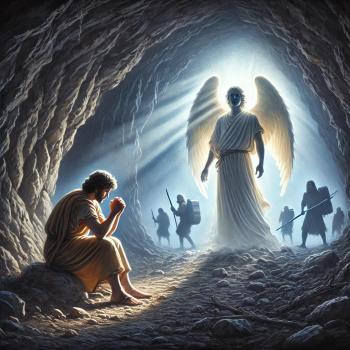Revelation 9:1-12 Demons On Parole
At Louisiana State University, Ricky McAlister acquired a small green New Testament from the Gideons, but stashed it away unread. Later, packing for a fishing trip, he tossed it into his gear for good luck. With two buddies, he drove through the night, arriving at their fishing spot early Monday morning. The weather was hot, the fish weren’t biting, and Ricky got nothing but a blistering sunburn. Ditto Tuesday. Finally, the guys gave up and collapsed in their room with a chest of beer.
We were sitting there waiting for the weather to cool off, when my friend asked, “Have you got any sports magazines?” I said, “Yeah, out in the car, but I’m not going to get ’em. It’s too hot.” He said, “Well throw me that little green Bible.”
He started thumbing through the Testament, then said, “Hey, listen to this.” He was reading from Revelation. I had never heard of Revelation. He started reading about these giant locusts that were going to come and eat on people. The more he read, the more afraid I became. I sat there and put my beer down. All I could think about was something I hate worse than anything, for a spider or snake to crawl on me. I would have dreams sometimes of things crawling on me or biting me, and I would be terrified.
He kept reading, and I got so afraid I was shaking. All this time the Lord had been dealing with me and I had been rejecting and rejecting. Well, I got to thinking about those locusts and I said, “Why don’t we go home?” While my friends went out to load the boat, I got that little Bible and started reading.
The next evening, Ricky attended a gospel service with his girlfriend, and there he gave his life to Christ. He later served the Lord in Bolivia, pastored in Louisiana, led one relative after another to Christ, and told audiences far and wide how he was driven to the Lord by a swarm of locusts. *12
The late Dr. Wilbur M. Smith, who made the Book of Revelation his special study, once wrote: “It is probable that, apart from the exact identification of Babylon in Revelation 17 and 18, the meaning of the two judgments in this chapter represents the most difficult major problem in the Revelation.” Revelation 9 describes two frightening armies that are liberated at just the right time and permitted to judge mankind.3 Beginning with the fifth trumpet (which we will deal with today) and sixth trumpets (which we will deal with next time), God judges unbelievers (known as the “inhabitants of the earth”), who respond with a stubborn devotion to wickedness and refuse to repent.
SEVEN FACTS ABOUT THE FIFTH TRUMPET JUDGMENT
The Policeman (Revelation 9:1)
“The fifth angel blew his trumpet, and I saw a star that had fallen from heaven to earth. The key to the shaft of the abyss was given to him.” (Revelation 9:1, HCSB)
God has angelic policemen who guard over certain places. There are two ways to interpret this verse. This is Satan – the fallen star – who is releasing his own demons, or this is an angel who releases demons as an act of judgment. The Greek word here is angel. This angel, like other angels has control over certain areas of God’s domain. In this case, God has prepared a special prison of solitary confinement for rebel angels in a place called the “Abyss.”
I believe with Scott Duvall, that “although falling stars can represent demons or even Satan (e.g., Jude 13; Luke 10:18; Revelation 12:9), here the descending star is an angelic messenger sent from God as an agent of judgment (See for example, the parallel figure in Revelation 20:1). God stands in sovereign control over the entire universe, the underworld included, and he gives this angel-star the key to the opening of the prison called the “Abyss.”4
The Prison (Revelation 9:2)
The prison is called the Abyss.
“He opened the shaft of the abyss, and smoke came up out of the shaft like smoke from a great furnace so that the sun and the air were darkened by the smoke from the shaft.” (Revelation 9:2, HCSB)
The Abyss is mentioned seven times in Revelation:
1. Revelation 9:1
2. Revelation 9:2
3. Revelation 9:11
4. Revelation 11:7
5. Revelation 17:8
6. Revelation 20:1
7. Revelation 20:3
The Abyss is a prison for spiritual beings who disobeyed God. In the Old Testament, the abyss is the place for evil people.
“Let hot coals fall on them. Let them be thrown into the fire, into the abyss, never again to rise.” (Psalm 140:10, HCSB)
In the New Testament, the abyss is a prison for demons – angels who disobeyed God.
“And they begged Him not to banish them to the abyss.” (Luke 8:31, HCSB)
The smoke darkens both the sun and air. Partly included is Exodus 10:15, which describes a swarm of locusts so great “that the land was darkened.” Note also the theme of darkness in the account of the locust plague in Joel 2:2, 10.5 It is a place of disorder and chaos, from where forces of death and darkness come to wreak their special kind of havoc. Hence, when the angel opened the Abyss, smoke rose from it like the smoke from a gigantic furnace.6
FIVE DIFFERENT ETERNAL LOCATIONS IN REVELATION
1. Heaven – the saved go to be with God
2. Hades – Hell, where the unsaved dead go before judgment
Hades in the New Testament represents a place of torment for the wicked. Jesus uses the term in this way in His condemnation of Capernaum in Matthew 11:23 (parallel Luke 10:15) and in the parable of the rich man and Lazarus in Luke 16:23 where the rich man is said to be “in torment in Hades.” When the term hades is used as the equivalent of the Hebrew sheʾol, as it is in Acts 2:27, 31 where Peter is quoting from Psalm 16:8–11, it refers simply to the grave. This is probably also the case in Revelation 20:13–14 whether the resurrection there includes only the wicked or also the righteous.7
3. The Abyss – the prison for demons who rejected God’s commands
4. Tartarus – the lower regions of Hell where divine punishment takes place
The Greek word Tartarus is for a subterranean place, lower than Hades, where divine punishment was conducted.8
In classical thought Tartarus was the lowest part of the underworld and a place of punishment over against Elysium, the place of the blessed. Thus it was distinct from Hades, the general abode of the dead, although in popular usage the two terms may have been interchangeable. In 2 Peter the name is used of the infernal region to which the rebellious angels were consigned, and hence here signifies a place of punishment of the wicked.9
5. The Lake of Fire – Hell, where the unsaved go after judgment
Two themes concerning Hades emerge in the last book of the New Testament. First, Jesus is the one who possesses power over Hades (Revelation 1:18).
“and the Living One. I was dead, but look—I am alive forever and ever, and I hold the keys of death and Hades.” (Revelation 1:18, HCSB)
Second, the lake of fire eventually will house all the “authors of evil” and all whose names are not found written in the book of life. Therefore, Hades itself is judged and thrown into the lake of fire (Revelation 20:13–14), the beast and false prophet are sent to the lake of fire (Revelation 19:20) and finally, the devil is thrown into the eternal fire (Revelation 20:10).10
The lake of fire is probably the same place that Jesus calls Gehenna (Matthew 10:28; Mark 9:43; Luke 12:5), the “outer darkness” (Matthew 8:12; 22:13; 25:30), and “the eternal fire prepared for the devil and his angels” (Matthew 25:41; compare Isaiah 66:24).11
So Hades is Hell. Tartarus is the lower part of Hell. The Lake of Fire is Hell. The Abyss is the demonic prison in Hell. So Hell has compartments. There is the Lake of Fire, where the beast and the false prophet will enter. There is Tartarus or the Abyss, the solitary confinement. There is the general region of Hell. Who lives in this Abyss? There are prisoners there.
The Prisoners (Revelation 9:3)
“Then locusts came out of the smoke on to the earth, and power was given to them like the power that scorpions have on the earth.” (Revelation 9:3, HCSB)
These are not literal locusts, because locusts do not have scorpion-like stings in their tails. These creatures do not devour the green vegetation; in fact, they are prohibited from doing so.12
There are two primary interpretations of who reside in this prison. The first is that they are demons who rejected God in Genesis 6 and were banished to this prison. There is some Scriptural evidence for this:
“and He has kept, with eternal chains in darkness for the judgment of the great day, the angels who did not keep their own position but deserted their proper dwelling.” (Jude 6, HCSB)
“For if God didn’t spare the angels who sinned but threw them down into Tartarus and delivered them to be kept in chains of darkness until judgment;” (2 Peter 2:4, HCSB)
So these prisoners are in prison from an event that happened in Genesis 6. The prisoners may come from this event, but it is possible that they are imprisoned for just this act on the world.
The Power (Revelation 9:4-5)
“They were told not to harm the grass of the earth, or any green plant, or any tree, but only people who do not have God’s seal on their foreheads. They were not permitted to kill them but were to torment them for five months; their torment is like the torment caused by a scorpion when it strikes a man.” (Revelation 9:4–5, HCSB)
Locusts destroy vegetation. They harm the earth. In this case, these demons hurt people. They torment people but won’t be able to kill them. Their torment is limited in time and scope. They are limited to five months and to only unbelievers. They have power, but once again as before, their power is restrained. They cannot do final harm.13
The Purpose (Revelation 9:6)
“In those days people will seek death and will not find it; they will long to die, but death will flee from them.” (Revelation 9:6, HCSB)
This demonic army is given the assignment of tormenting all who have not been protected by the seal of God.14
The Preparation (Revelation 9:7-10)
This demonic army was prepared for battle. They have been prepared to wage war on unbelievers so that they may turn to God.
Their head (Revelation 9:7)
“The appearance of the locusts was like horses equipped for battle. Something like gold crowns was on their heads; their faces were like men’s faces;” (Revelation 9:7, HCSB)
Their hair (Revelation 9:8)
“they had hair like women’s hair; their teeth were like lions’ teeth;” (Revelation 9:8, HCSB)
Their chest and wings (Revelation 9:9)
“they had chests like iron breastplates; the sound of their wings was like the sound of chariots with many horses rushing into battle;” (Revelation 9:9, HCSB)
Their tails (Revelation 9:10)
“and they had tails with stingers like scorpions, so that with their tails they had the power to harm people for five months.” (Revelation 9:10, HCSB)
The Prince of the Abyss (Revelation 9:11-12)
“They had as their king the angel of the abyss; his name in Hebrew is Abaddon, and in Greek he has the name Apollyon. The first woe has passed. There are still two more woes to come after this.” (Revelation 9:11–12, HCSB)
Their king is named by John as Abaddon (Hebrew), Apollyon (Greek). The word Abaddon in Hebrew has the meaning of destruction.
“Will Your faithful love be declared in the grave, Your faithfulness in Abaddon?” (Psalm 88:11, HCSB)
In this psalm, the psalmist cries out to God about His faithful love, even in the place of destruction (Abaddon).
“Sheol is naked before God, and Abaddon has no covering.” (Job 26:6, HCSB)
The point that Job is making is that God is sovereign over the grace and the one who provides the place of destruction. God has power over death and the location after death.
So these demonic hordes have spiritual significance. They emerge from the pit, the place of death; the pit is opened by someone who is a ‘fallen star’—no doubt Satan (Luke 10:18; Isaiah 14:12); Satan is ‘given’ divine authority to do this.15
1* Adapted from “A Little Green Testament” by Ricky McAlister, in Converted and Called (Nashville: The Gideons International, n.d.), pp. 83–85.
2 Robert J. Morgan, From This Verse: 365 Scriptures That Changed the World, electronic ed. (Nashville: Thomas Nelson Publishers, 2000).
3 Warren W. Wiersbe, The Bible Exposition Commentary, vol. 2 (Wheaton, IL: Victor Books, 1996), 594. See Wycliffe Bible Commentary, 1509.
4 J. Scott Duvall, Revelation, ed. Mark L. Strauss and John H. Walton, Teach the Text Commentary Series (Grand Rapids, MI: Baker Books, 2014), 131.
5 G. K. Beale and Sean M McDonough, “Revelation,” in Commentary on the New Testament Use of the Old Testament (Grand Rapids, MI; Nottingham, UK: Baker Academic; Apollos, 2007), 1114.
6 Robert W. Wall, Revelation, Understanding the Bible Commentary Series (Grand Rapids, MI: Baker Books, 2011), 128.
7 E. Ray Clendenen, “Hades,” ed. Chad Brand et al., Holman Illustrated Bible Dictionary (Nashville, TN: Holman Bible Publishers, 2003), 699.
8 David Seal, “Hell,” ed. John D. Barry et al., The Lexham Bible Dictionary (Bellingham, WA: Lexham Press, 2012, 2013, 2014, 2015).
9 Allen C. Myers, The Eerdmans Bible Dictionary (Grand Rapids, MI: Eerdmans, 1987), 479.
10 David Seal, “Hell,” ed. John D. Barry et al., The Lexham Bible Dictionary (Bellingham, WA: Lexham Press, 2012, 2013, 2014, 2015). See Bernstein, The Formation, 259, for more information.
11 Walter A. Elwell and Barry J. Beitzel, Baker Encyclopedia of the Bible (Grand Rapids, MI: Baker Book House, 1988), 1299.
12 Warren W. Wiersbe, The Bible Exposition Commentary, vol. 2 (Wheaton, IL: Victor Books, 1996), 595.
13 Earl F. Palmer and Lloyd J. Ogilvie, 1, 2 & 3 John / Revelation, vol. 35, The Preacher’s Commentary Series (Nashville, TN: Thomas Nelson Inc, 1982), 180.
14 Warren W. Wiersbe, The Bible Exposition Commentary, vol. 2 (Wheaton, IL: Victor Books, 1996), 595.
15 Michael Wilcock, The Message of Revelation: I Saw Heaven Opened, The Bible Speaks Today (Leicester, England; Downers Grove, IL: InterVarsity Press, 1986), 97.












